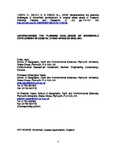Understanding the planning challenges of brownfield development in coastal urban areas of England
| dc.contributor.author | Leger, S | |
| dc.contributor.author | Balch, C | |
| dc.contributor.author | Essex, SJ | |
| dc.date.accessioned | 2017-01-26T09:30:57Z | |
| dc.date.issued | 2016-03-14 | |
| dc.identifier.issn | 0269-7459 | |
| dc.identifier.issn | 1360-0583 | |
| dc.identifier.uri | http://hdl.handle.net/10026.1/8311 | |
| dc.description | Available in Pearl https://pearl.plymouth.ac.uk/handle/10026.1/4528 deposited 20/4/16 | |
| dc.description.abstract |
Coastal settlements, whether rooted in port, defence or tourism economies, have experienced considerable economic, social and environmental change over the last 30–40 years, which has often resulted in building obsolescence and vacant land. Brownfield sites, especially on the waterfront, are strategically valuable, but can be constrained by costs of treatment, the fragmentation of available plots, complex landownership and declining property values. This paper addresses the need for a better understanding of the characteristics of brownfield land in English coastal communities and the challenges faced by planning in the regeneration of these sites through an analysis of the National Land Use Database and a survey of Heads of Planning Service. There is a plentiful supply of brownfield sites on the coast, but one-fifth requires remedial treatment and over half is concentrated in the ‘coastal challenges’ cluster. Economic circumstances and frequent policy shifts have impeded the redevelopment of brownfield land on the coast and forced greater pressure onto greenfield sites. | |
| dc.format.extent | 119-131 | |
| dc.language | en | |
| dc.language.iso | en | |
| dc.publisher | Informa UK Limited | |
| dc.relation.replaces | 10026.1/4528 | |
| dc.relation.replaces | http://hdl.handle.net/10026.1/4528 | |
| dc.subject | Brownfield | |
| dc.subject | coastal regeneration | |
| dc.subject | England | |
| dc.title | Understanding the planning challenges of brownfield development in coastal urban areas of England | |
| dc.type | journal-article | |
| dc.type | Article | |
| plymouth.issue | 2 | |
| plymouth.volume | 31 | |
| plymouth.publication-status | Published | |
| plymouth.journal | Planning Practice and Research | |
| dc.identifier.doi | 10.1080/02697459.2016.1146428 | |
| pubs.merge-from | 10026.1/4528 | |
| pubs.merge-from | http://hdl.handle.net/10026.1/4528 | |
| plymouth.organisational-group | /Plymouth | |
| plymouth.organisational-group | /Plymouth/Faculty of Science and Engineering | |
| plymouth.organisational-group | /Plymouth/Faculty of Science and Engineering/School of Geography, Earth and Environmental Sciences | |
| plymouth.organisational-group | /Plymouth/REF 2021 Researchers by UoA | |
| plymouth.organisational-group | /Plymouth/REF 2021 Researchers by UoA/UoA14 Geography and Environmental Studies | |
| plymouth.organisational-group | /Plymouth/Research Groups | |
| plymouth.organisational-group | /Plymouth/Research Groups/Centre for Research in Environment and Society (CeRES) | |
| plymouth.organisational-group | /Plymouth/Research Groups/Centre for Research in Environment and Society (CeRES)/CeRES (Reporting) | |
| plymouth.organisational-group | /Plymouth/Research Groups/Marine Institute | |
| plymouth.organisational-group | /Plymouth/Users by role | |
| plymouth.organisational-group | /Plymouth/Users by role/Academics | |
| dcterms.dateAccepted | 2016-01-17 | |
| dc.rights.embargodate | 2017-9-14 | |
| dc.identifier.eissn | 1360-0583 | |
| dc.rights.embargoperiod | 18 months | |
| rioxxterms.versionofrecord | 10.1080/02697459.2016.1146428 | |
| rioxxterms.licenseref.uri | http://www.rioxx.net/licenses/under-embargo-all-rights-reserved | |
| rioxxterms.licenseref.startdate | 2016-03-14 | |
| rioxxterms.type | Journal Article/Review |


